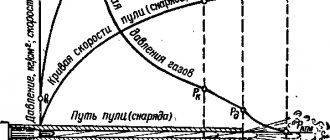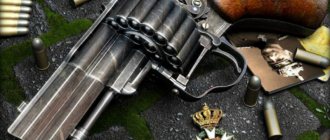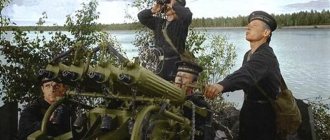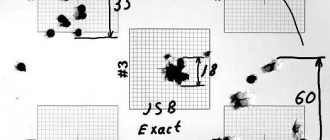The IZH-12 hunting rifle of 12 or 16 gauge is considered a legend among Russian hunters. This “over-and-under” of a classic design, equally well suited for both game and bird hunting and sport shooting, has now been discontinued, but many serviceable examples are still in demand on the secondary market. Now IZH-12 with restored barrels is considered a good gun for a novice hunter. It is distinguished by its reliability, unpretentiousness and high accuracy of combat.
History of creation
Smooth-bore weapons for civilian needs in the USSR began to be created only in the 50s. One of the first guns for hunting and sport shooting, which began to be mass-produced, was the 12-gauge IZH-59 “Sputnik” gun, designed by engineer Klimov. Production took place in Izhevsk, at the IZHMASH plant, which now belongs to the Kalashnikov concern. It served as a prototype for the creation of a more advanced model - IZH-12.
The production of the Sputnik model was discontinued 3-4 years after its start due to a number of inherent shortcomings in this gun, but many of its components formed the basis for the IZH-12 12-gauge double-barreled shotgun.
Weapons experts are still discussing the reasons for abandoning Sputnik. According to the most common opinion, the culprit was the coupling of the barrels to each other, which was considered unsuccessful. It was supposed to prevent deformation of the barrels during intense shooting, but in practice it worsened the accuracy of the battle. The weapon that replaced it was a smooth-bore gun with a vertical barrel arrangement and hidden triggers IZH-12, the barrels of which were no longer connected by couplings, but by soldering to a longitudinal bar.
Please note: the solder joint with silver containing solder was unusually reliable. The same applies to the barrels themselves - they were made of the highest quality weapon steel with uniform hardening along the entire length of the barrel. Many types of civilian weapons that IZHMASH subsequently produced were of worse quality than IZH-12.
Production of the double-barreled shotgun began in 1962 and continued until 1974. A total of 312 thousand pieces were produced, of which 129 thousand were exported abroad.
At the end of the 60s, the gun was modernized - it was supplemented with an automatic safety lock. But only a few of these double-barreled guns were produced, and now it is very difficult to find a suitable example with automatic shooting.
Design
The IZH-12 gun was produced in individual and mass versions, the latter differing, for example, in the absence of engraving on metal parts. This 12 or 16 gauge vertical rifle stood out for its simple and reliable design with a minimum of parts, in which there was practically nothing to break. The main mechanism, including the triggers, is hidden, which ensures its safety in bad weather conditions. It is extremely difficult for water, sand or dust to get into it.
The barrels have different muzzle constrictions, the so-called choke. At the upper trunk the narrowing is 1 mm, at the lower one - 0.5 mm (halfway). The surface of the barrels is chrome plated. A special feature of the gun is the pusher, which is located in the side grooves of the clutch. After the shots are fired and the barrel is broken, the cartridges are pulled out of the chambers halfway and then removed manually.
There is no ejector. Platooning is done by breaking the barrels. The triggers are made separately from the strikers. The hammers are brought into firing position by cockers located at the rear of the block. The trigger mechanism is designed in one block and is removed during disassembly.
USM Izh 12
The block is made of low carbon steel. Behind it are the shank and sear, and in the later version there is an automatic fuse. In early models, an interceptor acted as a fuse, which prevented an accidental shot without pressing the trigger. At the same time, the reliability of the gun is considered to be quite high: the interceptor blocks the trigger and the shot in the event of an accidental impact, fall, etc.
The power of the shock springs is sufficient to break the primer and fire even at low temperatures.
The butt and stock of the gun, as well as the fore-end, are wooden. They were made of walnut or beech; some models had a plastic or rubber butt pad on the butt. The forend is solid.
There are two triggers, each responsible for firing from “its own” barrel. Sights consisting of a rear sight and a front sight are installed on the upper barrel. The front sight is raised above the rear sight by 3 mm, which many consider a disadvantage, since you have to get used to this feature and make allowances when shooting.
When assembling the gun, you first need to lower the cockings down, and then snap the forend.
Specifications
The technical characteristics of the IZH-12 hunting rifle are as follows:
- bore diameter - 18.2 mm;
- cartridge - 12/70 or 16/70;
- barrel length - 720-730 (for 12 gauge) mm;
- gun weight - from 3.2 to 3.5 kg;
- barrel life according to the passport is 10,000 shots, in practice - up to 20,000;
- sighting range - up to 40 m.
It should be noted that the performance characteristics (TTX) of this double-barreled shotgun were calculated for a cartridge with a folder or paper sleeve. It is acceptable to use cartridges with a plastic sleeve, but metal ones are not suitable. They significantly increase recoil, reduce combat accuracy and increase reload time. Also, the use of metal cartridges, due to their significant mass, accelerates the wear of the weapon. In addition, metal wads have a diameter larger than the caliber of this gun, which also negatively affects accuracy.
The use of paper cartridges makes it possible to increase the accuracy when shooting with shot, depending on the shot numbers, to 7%. Professional shooters can use IZH-12 to hit targets at a distance of up to 70 m, including moving ones.
For shooting, shot numbers 0, 1, 2, 3, 6, 7 or bullets for smooth-bore weapons are used. You can use your own ammunition, but you must take into account that no more than 33 g of shot numbers 0, 1 or 2 are used, and 2.5 g of gunpowder is used for the same amount. This weapon does not like excessive charge amplification; the combat range will not increase when gunpowder is “loaded”, and the likelihood of the weapon failing will increase.
Photo Izh 12
Accuracy
Let's open a video blog of a gentleman known in Internet weapons circles with the nickname hickok45. This classic-looking American loves to shoot various types of weapons in more or less the same conditions - which is valuable. For lovers of the finest weapons nuances, such as “what happens if you hold your finger against the breech of a Nagant revolver during a shot,” the blog is strongly recommended for daily viewing instead of the “Time” program, as well as after midnight.
So, in the case we are considering, Mr. hickok45 asked a question on the subject: is it possible to hit a target, more or less reminiscent of a life-size one, with a bullet (and, to our general rejoicing, precisely a Foster bullet) at a distance of 230 yards?
In fact, in the vast majority of his releases, their author shoots at close range, sometimes shooting back at 70-75 meters. However, no, no, but the topic of 230 yards will also come up, and specifically in relation to weapons that are not suitable for such ranges. Oh, for good reason... Ask if you have the chance. The vertical correction is especially characteristic when shooting from the old M1911.
But now we are interested in the smoothbore. In this case, however, it is not a Remington 870, but a Benelli Super 90. Let’s look and empathize:
As you can see, the bullet flies to the target for about a second and, if the camera is not lying, arrives at it after the sound wave. This, by the way, is a fundamental point: it is believed that the reverse transition of the sound barrier is critical for a number of ammunition (including rifled ones). And in aviation, a change in the nature of the flow at transonic speeds at one time led to a series of disasters. Not the “conquest of sound” as such (although there is a graveyard there), namely, the problem of balancing and controllability at transition speeds, i.e. at M=1.
And here, it means that the bullet leaves quite round holes and is not going to deviate much. And this, we note, without any stabilizer shanks - just a homespun piece of lead of the required shape. At a distance at which the front sight covers the target almost twice, the bullet flies steadily!
“It’s understandable,” the meticulous reader will say, “after all, a real master shoots, and the barrel, frankly speaking, is not cheap.”
That's how it is. But then a simple American girl, Kirsty (and not Christie, as we would like), went out, as they say, into an open field and shot at 250 yards with a folk shotgun:
The result is 4 hits out of 6 shots, also on a smaller target. The bullet's flight time is still around a second, and the cartridge is the same - a Winchester with a Foster bullet, of course, a 70 mm cartridge case. There are no magnums there, just like Hickok45.
Thus, we see that on that fateful February morning, the police still had a theoretical chance of hitting the criminals with their shotguns, and it is possible that such hits did occur. Moreover, one robber was shot with a bullet from a gun (whether he shot himself or not is a second question). But most likely, the firing distance was reduced - judging by the TV recording, the distance was about 50 m.
Of course, sitting in front of a computer, it’s easy to talk about hitting a target that terrifies everything living and even nonliving around. But we also have the right to generalize experience at our level.
What if they start collecting collectors near our windows? We’ll drive the Diabla tightly into the barrel... I don’t even know if this is a joke.
But let's go back, so to speak, overseas.
What was the share of guns in that conflict, if you do not take into account the “final chord”? Only an examination of the bodies and body armor can tell about this...it is unlikely that these results are widely available. I have no doubt that the medical and pathological conclusions were made with full responsibility, but... was there a detailed analysis, for example, of the consequences of bruises under armor protection? Shotgun/pistol and rifle/pistol wound ratios?
Advantages and disadvantages
Many hunters believe that this is a good shotgun for hunting, capable of shooting very accurately. It has good weight distribution and balance. Among over-and-under shotguns, the IZH12 stands out for its lowest price with decent combat characteristics
Let us list the main advantages of the 16 or 12 gauge IZH-12 shotgun:
- low price;
- simple design;
- unpretentiousness and reliability;
- ease of maintenance;
- good balance;
- high accuracy;
- good fight;
- classic design.
The gun allows the use of both factory and homemade cartridges, subject to the equipment rules described above. Exceeding the maximum mass of shot can create problems with removing cartridges after a shot, but in general the IZH-12 is favorable to homemade cartridges, unlike many modern guns. Barrels made of hardened steel fastened with silver solder have a very high service life: many guns with a service life of half a century, if their owners were not very active hunters or amateur shooters, have retained the ability to shoot to this day.
But it also has a number of disadvantages. First of all this:
- solidly machined forend;
- very close location of the triggers;
- the “pull-up” effect, when the shot is delayed when the trigger is pressed;
- a characteristic “bevel” of the sighting bar, which makes it difficult to shoot accurately for the first time and forces you to relearn specifically for this vertical (if in the future you want to change the gun, you will have to relearn it back).
The forend, machined from one piece of wood, has a groove that is too deep. The predecessor of this weapon, IZH-59, was composed of two separate parts. Because of this, the forend is easy to damage or break.
Unusually, the proximity of the triggers makes it difficult to move your finger from one to the other. In addition, this weapon is characterized by an unpleasant “lag” effect, when when you press the second trigger immediately after the first shot, the shot is delayed by about 0.5-1 second. Out of habit, it seems that the trigger is out of order. This feature of the gun can be detrimental if you need to shoot a doublet.
You will also have to get used to the specifics of its sighting devices.
Energy
For the second question arises in all its unpleasant growth: what is the lethal effect of Foster’s bullet at the distances of the shootout under discussion?
You can, again, do everything yourself: take ballistic gel (gelatin), put a good class bulletproof vest on it, hang the entire structure from a branch and fire from a distance of 200 m, filming the process close-up. In general, there may be different methods - including compressed foam under the body armor, although fixation is already needed here.
But while we don’t have the necessary components at hand, let’s turn to the primary sources.
To do this, let’s look at the websites of leading manufacturers in order to inquire about low-power cartridges equipped with a Foster bullet weighing 1 ounce and with an initial speed of 1200-1400 ft/sec (28.3 g and 366-427 m/sec, respectively). The most visual data is presented in the form of a graph:
Energy versus distance for FederalPremium PB127LRS cartridge
Note that at distances over 120 yards the bullet energy can only be approximated and at 200 yards it is expected to be approximately 300 foot-pounds - which is comparable to the muzzle energy of a Parabellum cartridge.
Why did we take the most delicate cartridge as an example?
Because in the USA it is believed that both self-defense and police cartridges should have low recoil so as not to tire the shooter. After all, the police, one must think, shoot at least 50 rounds of ammunition every day, and their shoulders hurt - and self-defense workers, too, apparently, are such nerds that even standard recoil is worse for them than an uninvited guest.
There is, of course, a stronger justification - what if a police bullet/buckshot goes where it shouldn’t due, supposedly, to excess power? And at least it will work.
Due to such humanism, the cost of low-impulse ammunition is a surprise! - also very gentle. And if an evil self-defender can afford to stock up on expensive ammunition and pound his shoulder to his heart's content with increased recoil, then the security forces have just less choice.
“But there are powerful magnum cartridges!” - the meticulous reader will be indignant - “you can have a couple of pieces with you just for such an occasion. Even if it hits your hand, concussion is guaranteed.”
Of course, there are such cartridges! But, apparently, the police did not take them with them that time.
Here is the most powerful ammunition with a similar bullet:
Energy versus distance for FederalPremium F131RS cartridge
Estimated energy at 200 yards is 600 ft-lb, which is double the previous (read: standard police) ammo at the same range and approaches the muzzle energy of a .357 Magnum.
However, regarding the power of self-defense ammunition, the author once exuded sarcasm.










